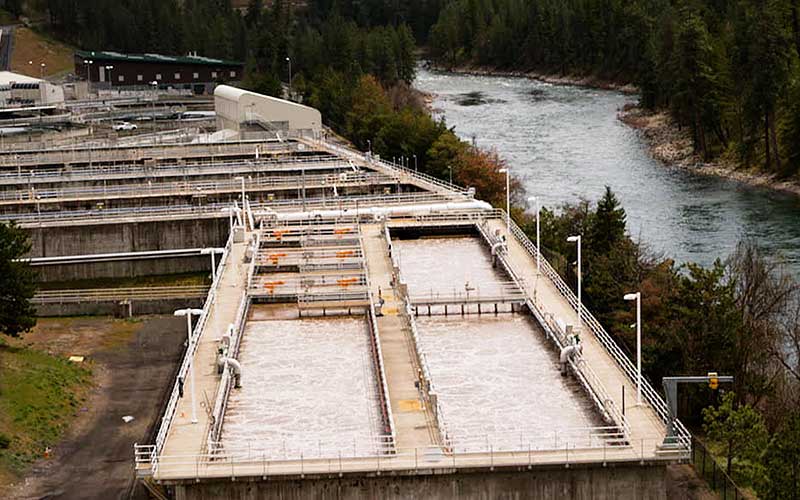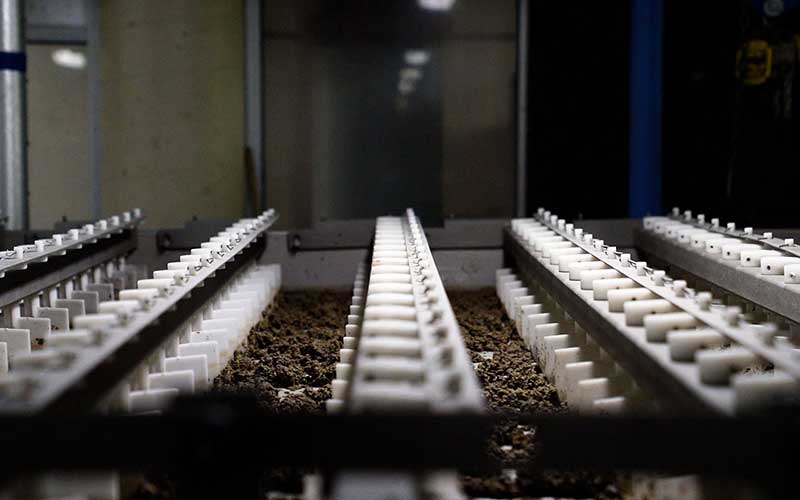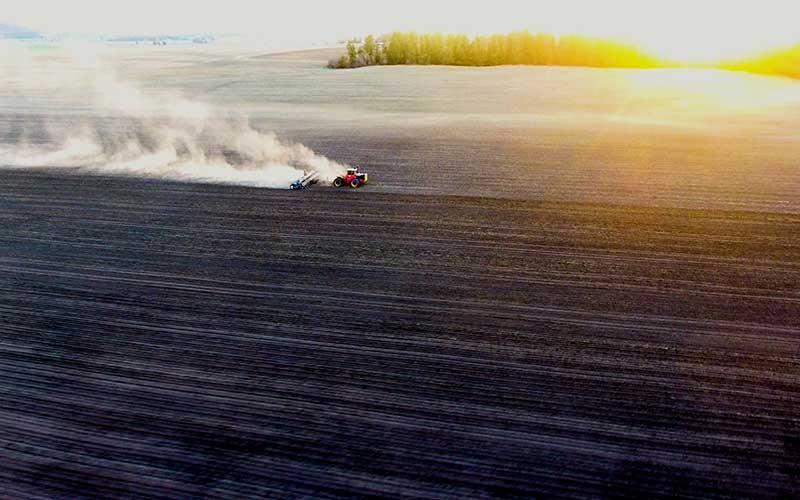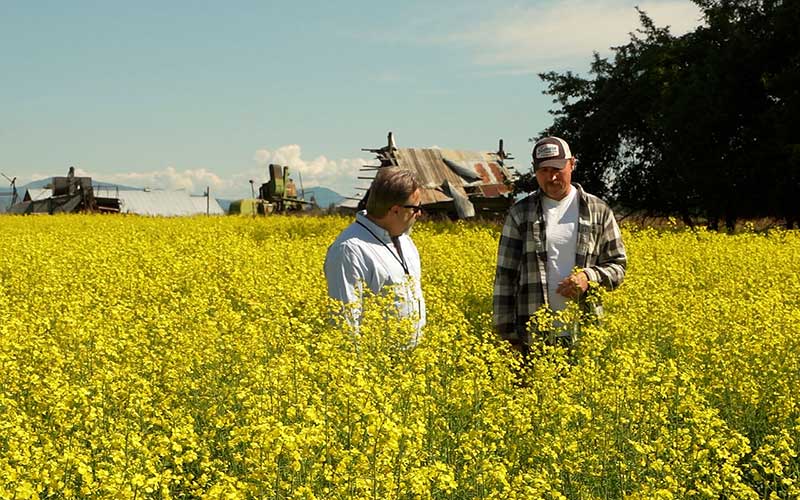Biosolids
Biosolids are a product of municipal wastewater treatment facilities. Biosolids are a primarily organic, semisolid product resulting from the wastewater treatment process and can be beneficially recycled. Because biosolids contain essential plant nutrients and organic matter, they can be treated, processed and used as a soil amendment and nutrient source to improve and maintain productive soils and stimulate plant growth. However, the treatment process must meet all applicable requirements and regulatory standards under state law before the biosolids can be applied to the land (Chapter 70.95J RCW). The State Environmental Policy Act (SEPA) process identifies and analyzes environmental impacts associated with land application of biosolids. View the current SEPA for the City of Spokane's Biosolids program.
The U.S. Environmental Protection Agency (EPA) has advocated responsible biosolids management programs for years. Washington’s state legislature established a state biosolids program in 1992 when it declared that “a program shall be established to manage municipal sewage sludge and the program shall, to the maximum extent possible, ensure that municipal sewage sludge is reused as a beneficial commodity and is managed in a manner that minimizes risk to public health and environment” (Chapter 70A.226.005 RCW).

Recycling biosolids is good for the environment. When properly applied and managed, biosolids can provide essential plant nutrients, improve soil structure and tilth, add organic matter, enhance moisture retention, and reduce soil erosion. The Riverside Park Water Reclamation Facility has been utilizing biosolids since approximately 1982 to supply local dry land wheat farmers that occasionally grow sunflowers and canola. Our facility applies biosolids, on average, on about 3,000 acres per year!

FAQs
What are biosolids?
Biosolids are a soil-like byproduct of the wastewater treatment process comprised primarily of solid and organic matter. In Washington, biosolids can only be disposed of in landfills, destroyed through incineration, or reused as a “beneficial use.” Beneficial use is the only practice considered sustainable because it returns organic matter and nutrients to areas where they are needed most: areas used for farming and forestry.(1) On the contrary, landfilling and incineration can result in undesirable environmental impacts. Beneficial use is accomplished via the responsible practice of land application. Through this practice, farmers utilize nutrient-rich biosolids fertilizer in place of synthetic commercial fertilizers. A high organic matter content also allows biosolids to act as a soil amendment, thereby improving the overall soil health of croplands that it is applied to. Over 60% of the biosolids produced in Washington are beneficially reused through land application.(1)
What happens to Spokane’s biosolids?
Biosolids are a soil-like byproduct of the wastewater treatment process comprised primarily of solid and organic matter. In Washington, biosolids can only be disposed of in landfills, destroyed through incineration, or reused as a “beneficial use.” Beneficial use is the only practice considered sustainable because it returns organic matter and nutrients to areas where they are needed most: areas used for farming and forestry.1 On the contrary, landfilling and incineration can result in undesirable environmental impacts. Beneficial use is accomplished via the responsible practice of land application. Through this practice, farmers utilize nutrient-rich biosolids fertilizer in place of synthetic commercial fertilizers. A high organic matter content also allows biosolids to act as a soil amendment, thereby improving the overall soil health of croplands that it is applied to. Over 60% of the biosolids produced in Washington are beneficially reused through land application.
Do biosolids work?
Biosolids are a significant source of organic matter, nutrients, and micronutrients. Biosolids can provide a crop with nitrogen, phosphorus, potassium, sulfur, calcium, magnesium, zinc, and other elements. Unlike synthetic fertilizers, biosolids nutrients are present in both rapidly available and slowly available forms due to the large amount of organic matter.(2) In addition, an abundant amount of research has revealed that farm soil amended with biosolids can have increased water retention, increased aeration, improved erosion control, improved soil structure, improved tilth, improved friability, and, ultimately, better crop yields.(2)(3)
What does it cost?
Currently, the City of Spokane is offering biosolids to farmers at no monetary cost. This means the City of Spokane will haul the biosolids to your property and apply the biosolids to your fields using our specialized equipment. Additionally, we will take care of all the routine sampling and laboratory analysis of your soil that is required for regulatory purposes and the safe and responsible application of biosolids. The only requirement of the farmer is to be flexible with the timing of crops and work with our program’s schedule.
Which crops can I have biosolids applied to?
Currently, we apply our Class B biosolids to non-irrigated fields that will be planted with wheat and canola. Other dryland crops like oats, barley, sunflowers can also be planted on fields amended with biosolids. We do not apply biosolids to orchards or fields used for root crops and vegetables.
How much biosolids are applied?
The amount of biosolids applied to a field is determined by our chemists according to a calculated Agronomic Loading Rate or ALR. ALRs are calculated using the Washington State University Pacific Northwest Extension Publication PNW0511e (Cogger/Sullivan Worksheet) that takes into account a number of factors: biosolids nutrients, existing soil nutrients, crop nutrient growth requirements, expected yield, and previous biosolids applications. Because each ALR uses variables that are field-specific and time-dependent, ALRs are calculated to fit each field’s specific crop the farmer has planned for it. After the numbers are crunched, this typically results in an ALR of two to five dry tons per acre (DT/acre). Our spreaders are calibrated to apply biosolids to the exact loading rate to ensure complete coverage, even distribution, and avoidance of over- and under-application.
When are biosolids applied?
Biosolids can be applied any time the field is in fallow or stubble as long as the soil is not frozen or covered in snow. In the winter, biosolids are bunkered (stored in piles) on site and spread the following spring.
How often are biosolids applied?
Biosolids can be applied once per year but, most often, they are applied every two to four years.?The nature of biosolids ensures lasting nutrient availability and soil benefits that improve with repeated applications.
Is land ownership required?
No. As long as the landowner consents and signs a Landowner’s Agreement, you can have biosolids applied to the property.
Do biosolids smell?
People commonly perceive biosolids as having an earthy or slightly musty odor. Odor most commonly becomes an issue when applied close to residential areas and only for a short period immediately following application. Unwanted odors are commonly reduced or eliminated by tilling biosolids into the soil or just letting nature take its course and allowing biosolids to become incorporated into the soil.
Are biosolids safe?
A joint policy statement of the U.S. Department of Agriculture, the U.S. Food & Drug Administration, and the U.S. Environmental Protection Agency states, “...the use of high quality biosolids coupled with proper management procedures, should safeguard the consumer from contaminated crops and minimize any potential adverse effect on the environment” (U.S. EPA, 1981).(3)
Our biosolids land application program is overseen by the Washington State Department of Ecology and the U.S. Environmental Protection Agency and subject to those agency’s strict and comprehensive regulations to ensure human and environmental safety. Our treatment processes and land application practices must comply with all applicable regulatory standards and requirements. Additionally, modern regulatory controls on what is discharged to sewers paired with our state-of-the-art treatment facility ensure our biosolids are safe and of the highest quality.
What about germs?
The most common misconception about land application of biosolids is that “raw sewage” is spread into fields that grow food. This could not be further from the truth. Our ultra-modern wastewater treatment plant utilizes a combination of mechanical, chemical, and biological processes to separate, treat, and sanitize wastewater into three clean products: clean liquid effluent, clean biosolids, and clean biogas. With biosolids, our treatment process utilizes digesters to subject solids to extended anaerobic conditions where microorganisms break down organic matter and remove pathogenic bacteria. Dewatering processes remove water and result in a product with a soil-like consistency. Together, the treatment processes result in a safe and useful commodity: biosolids. Further destruction of bacteria is accomplished after biosolids are applied to fields and exposed to sunlight, dry conditions, and other environmental conditions during a 30-day period in which public access is restricted. Additionally, biosolids are only spread on fields that grow products that are heavily processed. That is, only grain and seed crops - never fruits, vegetables or other foods that come directly in contact with soil.
What about nitrates in the groundwater?
Over-application of any fertilizer, biosolids included, can results in excess nutrients (primarily nitrogen) leaching from the soil to the groundwater. Since the City of Spokane tests the farm soils in our program on a regular basis, we can calculate application rates that provide an optimal amount of nutrients to your crops. In addition, the nature of biosolids act as a slow-release fertilizer, providing controlled and lasting supply of nutrients to crops. By comparison, synthetic fertilizers are much more likely to leach into groundwater since nitrogen is not bound up in organic material but highly soluble and, as a result, mobile.
What about heavy metals?
Heavy metals may be present in biosolids. However, the concentration of metals in wastewater has drastically declined since the 1980’s when tighter controls were placed on industrial sources, PVC replaced metal pipes and cities increased water supply pH to reduce pipe corrosion.(2) Even after dramatic reductions in heavy metals being discharged to the sewer system, state and federal regulations have continued to impose strict limits, routine monitoring, and stringent reporting requirements that prevent accumulation of metals to harmful levels in biosolids. Our biosolids are tested in third-party, state-accredited labs on a routine basis to ensure safety and compliance with all regulations. Our test results consistently fall well below limits imposed by the State and Federal regulations found in WAC 173-308-160 Table 3.
What about PFAS?
PFAS, also known as “forever chemicals,” are a family of synthetic compounds used in a wide range of consumer products and industrial applications. Because they are found in clothing, carpets, cleaning agents, food wrappers, food, personal care products, cosmetics, drinking water, and even household dust, everyday activities remain, by far, the most significant route of exposure to these chemicals.(4)
Due to their ubiquitous nature, it is no surprise they will end up in wastewater and biosolids. However, peer-reviewed research clearly demonstrates that land application of biosolids, even when repeated over years, does not result in soil or groundwater concentrations of PFAS to levels that pose a threat to human health or the environment.(4) To elaborate, a study by the University of Arizona and Pima County, the largest study of its kind, found the following:
- “Analysis of soil samples from undisturbed sites with no history of land application of biosolids or irrigation were all non-detectable at all soil depths tested.”(4)
- “Samples from irrigated agricultural sites with no history of biosolids application demonstrates low concentrations of PFAS, less than 3 ppb. Analysis of some irrigation waters were also positive for PFAS, suggesting that irrigation alone can be a source of PFAS in soils. PFAS in irrigation water did not appear to correlate to biosolids application.”(4)
- “Agricultural soils that were irrigated and received biosolids contained PFAS, but again at very low concentrations. PFAS soil concentrations detected were low and minimally increased with increased biosolids loading, from less than 2 ppb at the lowest biosolids application rate to 4 ppb at the highest loading rate. These concentrations are well below health-based screening levels developed for residential soil established by EPA.”(4)
- The limited migration of PFAS within soils. Even in the irrigated agricultural soils, over 90% of the PFAS was attenuated within the top 6 feet of soil, with the vast majority being trapped in the surface foot of soil. Because depth to groundwater in Pima County regional agricultural areas is typically 150 – 200 feet beneath the surface, contamination of groundwater from biosolids application is extremely unlikely and is supported by the groundwater results.(4)
The City of Spokane complies with all federal and state rules, regulations and guidelines concerning PFAS. Throughout our history, we have been stewards of public health and the environment by providing the safe and effective treatment of Spokane’s wastewater. We will continue to take PFAS seriously as we keep up to date on all research surrounding this subject as it evolves.
Still have questions? For a deeper dive into biosolids check out this article from the Pacific Northwest Extension Publishing (PDF 945 KB).
References
- “Learn about biosolids - Washington State Department of Ecology.” (n.d.). https://ecology.wa.gov/Waste-Toxics/Reducing-recycling-waste/Biosolids/Learn-about.
- Sullivan et al. (2022). “Fertilizing with Biosolids.” Pacific Northwest Extension Publishing.
- U.S. Environmental Protection Agency. (2000). “Biosolids Technology Fact Sheet, Land Application of Biosolids.” U.S. Environmental Protection Agency.
- Pima County Wastewater Reclamation. (2020). “PFAS in Biosolids, A Southern Arizona Case Study.”
Contact Information
Biosolids Program
Wastewater Management
509.625.4600
biosolids@spokanecity.org


